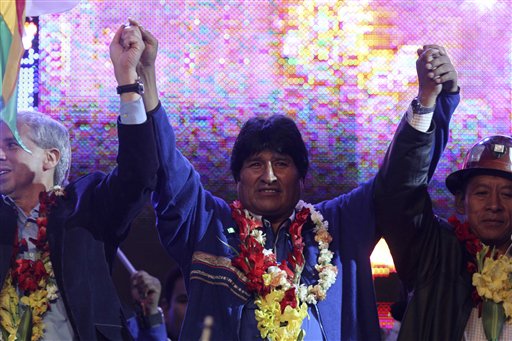
(above) Bolivia's President Evo Morales, center, raises vice president Alvaro Garcia Linera, left, and Bolivia's Trade Union president Pedro Montes' arms during a campaign rally in El Alto, Bolivia, Thursday, Dec. 3, 2009. Morales is seeking reelection on Dec. 6 presidential elections. (AP Photo/Juan Karita)
11 Photos -- Go to Original story
In Bolivia vote, Indian power a central issue
December4, 209 - Associated Press
By FRANK BAJAK (AP)
CHARAGUA, Bolivia — In Bolivia's biggest municipality, a scrub-brush expanse of cattle ranches and hardscrabble farms, Sunday's national elections aren't all about Evo Morales.
With Bolivia's first indigenous president expected to easily win re-election to a five-year term, the focus in Charagua is on the drive for greater political power by the Indian majority of this poor South American nation.
The Ireland-sized municipality is one of 12 that vote Sunday on whether to abandon modern political structures in favor of traditional native governance, with major decisions taken by public assemblies.
The prospect has galvanized the Guarani, the third-largest of the 36 ethnic groups with rights to self-determination enshrined in a new constitution backed by Morales that Bolivians ratified in January.
With Morales' help, the Guarani have been dismantling the last vestiges of oppression that U.N. investigators in May described as "forced labor and servitude." Indian families here in the Chaco region provided live-in labor for large landholders, typically receiving nothing more than food and clothing in exchange.
"That's what the Guarani people have achieved: breaking (the landowners') feudal power," says Miguel Valdez, a researcher at the nonprofit Center for Research and Promotion of the Peasantry, or CIPCA. "It's a revolution."
The Guarani, who number about 85,000 in Bolivia and also live in neighboring Paraguay, Brazil and Argentina, also hope to gain their first seat ever in Bolivia's Congress on Sunday as voters elect a new 36-member Senate and 130-member lower house.
Their candidate is Wilson Changaray, president of the Guarani's People's Assembly, the group's governing body in Bolivia. It was revived in 1987 following the restoration of democracy to Bolivia, a full century after government troops crushed a Guarani uprising in the Chaco region.
"Charagua was the nest, the bastion of the big landholders, the great dictators," says Changaray, a 42-year-old farmer's son with a boxer's build. Typical of many Guarani leaders, he never finished elementary school. It was a three-mile (five-kilometer) walk each way,
But Changaray says white minority domination is coming undone in Charagua — where 70 percent of the 28,000 people are Guarani — by the time Morales' took office in 2005. The new government soon ordered tens of thousands of hectares (acres) of fallow land seized from large landholders here in Bolivia's eastern lowlands and turned it over to indigenous communities.
Although there have been flare-ups of violence — one in September 2008 in the opposition-led eastern state of Pando cost 19 lives — the transition has been mostly peaceful.
The political muscle-flexing of his Guarani allies could help Morales, as an Aymara a member of Bolivia's largest indigenous group, extend his influence in the eastern lowlands, which are dominated by his pro-capitalist opposition.
Changaray is running for Congress on the ticket of Morales' governing Movement Toward Socialism (MAS) in Santa Cruz state — the center of the opposition — against an incumbent backed by Morales' fiercest foes. The district includes Charagua.
The president of the Santa Cruz Cattleman's Federation, Guido Nayar, accuses Morales of using the Guarani to push for splitting off a separate Chaco state that he and his allies can control.
"What's being sought is the territorial division of the country," he said in a telephone interview, noting that Guarani's traditional homeland also holds Bolivia's richest natural gas and oil deposits.
Guarani leaders say they do not aspire to create a new state, but want to eventually have a self-governing territory that spans Santa Cruz and two other current states.
And Changaray calls accusations about control of gas and oil misleading. He notes that the central government has a monopoly on subsoil rights that indigenous autonomies can't threaten.
For him, the fight is about improving education and economic opportunity — and restoring Guarani access to land.
Currently, the owners of five ranches totaling 36,000 hectares (140 square miles) in the Andes eastern foothills just west of Charagua — including a Montanan named Ronald Larsen — are in court fighting a government order to give up the property to the Guarani because the government says it found conditions of servitude on them.
Charagua elected its first Indian mayor in 2005 and four of the five municipal council members are Guarani.
Many more Indians are expected to take over city halls here in the Chaco in April, when Bolivia's municipalities and states elect new mayors and governors.
The administration has been building schools and hopes to attract more health workers. And Morales' government founded a Guarani university in the region, though there's little employment to keep degree-earners in the Chaco.
The dirt-poor Guarani settlement of Rancho Nuevo, where Changaray held a rally Thursday, attests to the challenges.
It sits on the banks of the Parapeti river, which at this low altitude is nothing more than a huge sand flat for half the year. Many of the town's 1,600 residents migrate north to cut sugar cane for months at a time.
Chagas disease, which is sometimes fatal, afflicts the children; insects that transmit the blood parasite that cause it breed in the mud walls of the town's homes.
The people raise cattle, goats and pigs and a little rice, but they can't get to market.
"When it rains, the road gets terrible — at times impassable," says Gabriel Ayala, the 63-year-old village leader.
And indeed, as Changaray's rally begins, the skies open up, turning the dirt track to the village into muddy slop that have even four-wheel-drive vehicles slithering off into ditches.